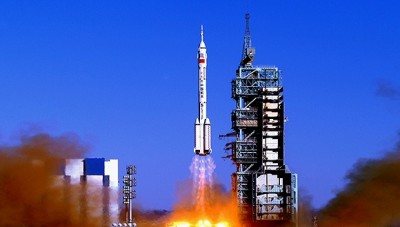China’s Manned Space Mission. Reentry and Return of Shenzhou-11 Space Capsule
Success of Manned Space Mission Brings China to New “Long March”

The success of China’s longest-ever manned space mission is a symbol of the new heights reached by the Chinese space program, the People’s Daily commented on Saturday, after two Chinese astronauts successfully returned to Earth after 30 days in space.
The reentry module of Shenzhou-11 landed safely at the designated site in central Inner Mongolia Autonomous Region at about 1:59 pm Friday Beijing Time.
The following is a translation of the People’s Daily article provided for publication to Global Research:
The Chinese space heroes have returned after completing their 30-plus-day mission. The Shenzhou-11 space capsule landed safely in Inner Mongolia with astronauts Jing Haipeng and Chen Dong on board. This historic moment is so momentous that it has lifted the spirit of every Chinese citizen.
This moment will go down in the history books to be remembered for generations to come. Over the past five weeks, the two astronauts completed a series of scientific and technical experiments in the Tiangong-2 space laboratory, setting a record as China’s longest crewed mission to date.
The success not only marked an important and decisive achievement in terms of the projects completed in the space lab, but also laid the foundation for follow-up construction and operation of a functional space station. Chinese manned space science has finally risen to a new level.
This will always be a proud moment for the Chinese people. China started its space exploration journey 60 years ago from scratch, but has now grown into a world space power. The “Two Bombs, One Satellite” project, the lunar exploration program as well as the Beidou Navigation Satellite System are evidence of China’s progress and strength as a major world power.
In just 24 years, China has mastered the three most important technologies in manned space, namely the earth-to-orbit transportation system, extravehicular activity (EVA) and space rendezvous and docking, which signals that it will not be long before China realizes its goal of operating a permanent space station as well as conducting space application on a large scale.
The Chinese people who have suffered in the “age of navigation” can finally hold their heads up high.
Despite difficulties faced along the journey, China has, with its unremitting efforts, staunch determination and independent innovation, finally made seminal breakthroughs in key space technologies, applied its research results to the industrial, agricultural and service sectors, upgraded technologies of relevant industries, and brought tangible benefits to the public.
As of the end of the 12th Five-Year Plan period, China has completed 42 commercial launches for 25 nations and international organizations, launched 48 satellites, provided 10 carrying services, delivered nine whole spacecrafts, managed to export its basic aerospace facilities, and expanded the international market of satellite application, thus making great contributions to the peaceful exploration and use of outer space.
The praise received from the international community acknowledges China’s efforts in space technology and the peaceful development of mankind.
A nation should be self-reliant in order to survive in the international arena. Space exploration relies on perseverance and independent innovation. In the past six decades, Chinese space scientists upheld the spirit shown both in the “Two Bombs, One Satellite” project and manned spacecraft science research, while always placing the national interest and the needs of the people first.
Their innovation, perseverance, solidarity and dedication, the most precious legacies of this era, propel the modern rejuvenation of China.
The dream of space exploration is part of the dream of rejuvenation. China today needs strategic scientific support more than ever. It has yet to complete the national strategy that maps out three major steps to promote manned space, and also needs more efforts in deep space exploration and application of space technologies.
China should prioritize space science development, implement innovation-driven national development strategies and focus on independent innovation and groundbreaking technological innovations. The future success of the “Long March” and space exploration as a whole hinge on continued efforts from us all.

